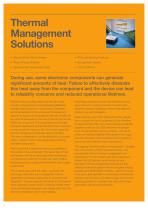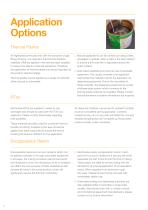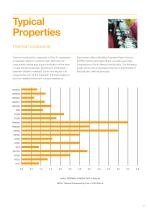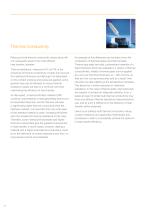
Catalog excerpts

Thermal Management Solutions Created to perform when the heat is on ELECTROLUBE THE SOLUTIONS PEOPLE
Open the catalog to page 1
• RTVs and Bonding Products • Encapsulation Resins • 0.9 to 5.5W/m.K Thermal Management Solutions • Silicone & Non-Silicone Pastes • Phase Change Materials • Silicone & Non-Silicone Gap Pads During use, some electronic components can generate significant amounts of heat. Failure to effectively dissipate this heat away from the component and the device can lead to reliability concerns and reduced operational lifetimes. Newton’s law of cooling states that the rate of loss of heat is proportional to the temperature difference between the body and its surroundings. Therefore, as the temperature...
Open the catalog to page 2
Thermal Pastes Thermally conductive pastes consist of thermally conductive fillers in a carrier fluid. Thermal pastes do not cure; therefore, they offer the best solution when rework is important and provide versatility by avoiding geometrical restrictions affecting cure. Silicone and Silicone-Free Electrolube offers silicone and non-silicone thermal pastes. The silicone products offer a higher upper temperature limit of 200°C and a lower viscosity system, due to the silicone base oil used. The use of products based on, or containing, silicone may not be authorised in certain applications....
Open the catalog to page 3
The ‘Xtra’ Range Electrolube’s ‘Xtra’ range of thermal products are enhanced versions of the non-silicone products HTC and HTCP. These ‘X’ versions are manufactured using one of the company’s proprietary technologies and possess the following benefits with almost no compromise in usability and viscosity: an increase in the comparative thermal conductivity, lower oil bleed and lower evaporation weight loss. HTCPX is mainly used as a gap filler and has been approved by one of the top manufacturers in the automotive industry. The ‘Xtra’ range of products are also more resistant to humidity and...
Open the catalog to page 4
Phase-Change Materials Phase-Change Material Phase change materials have been designed to combine the very low thermal resistance achieved using a thermal paste, with the stability of a cured or solid material, such as an RTV or gap pad. Their name is derived from their properties during use, changing state from a solid to a liquid and back again depending on the temperature of the application. Each phase change material will have its' own softening temperature, at which the change of state occurs. Once this temperature is reached, the ability of the phase change material to become softer...
Open the catalog to page 5
Application Options Thermal Pastes As highlighted previously and with the exception of gap filling products, it is important that thermal interface materials (TIM) are applied in the thinnest layer possible to reduce the effects of thermal resistance. Therefore, the application of thermal pastes can be as important as the product selection stage. Thermal pastes can be applied via a range of methods, either manual or automated. Electrolube RTVs are supplied in ready-to-use cartridges and should be used with the TCR Gun applicator. Please contact Electrolube regarding bulk quantities. These...
Open the catalog to page 6
Gap Pads Thermal gap pads are used in place of traditional thermal interface materials (TIMs) such as a thermal paste or RTV. The main benefit of gap pads is that they offer a quick and easy application method, requiring minimal training for the operator and without the mess sometimes associated with a paste, grease or bonding product. In addition, they do not require the use of expensive dispensing machines and can easily be applied via a manual process. Gap pads are often cut to size to fit the requirements of the specific interface application. They work in a similar manner to other...
Open the catalog to page 7
Adhesives & Encapsulants Adhesives and RTVs Electrolube offer a thermal bonding adhesive called TBS, as well as two RTV (room temperature vulcanising) products: TCOR and TCER. TBS (Thermal Bonding System) is a two-part, high strength epoxy adhesive designed to bond a heat sink to the component. In addition to the mineral fillers, the adhesive contains small glass beads of controlled diameter: these allow for a set thickness of 200 microns to be achieved, providing optimal performance. TCOR and TCER are Electrolube’s silicone RTV products. TCOR is an oxime-cure RTV, and TCER is...
Open the catalog to page 8
Typical Properties Thermal Conductivity Thermal conductivity, measured in W/m.K, represents a materials’ ability to conduct heat. Bulk thermal conductivity values give a good indication of the level of heat transfer expected, allowing for comparison between different materials. Some techniques only measure the sum of the materials’ thermal resistance and the material/instrument contact resistance. Electrolube utilise a Modified Transient Plane Source (MTPS) method amongst others, providing accurate comparisons of bulk thermal conductivity. The following graph shows the comparative thermal...
Open the catalog to page 9
Relying on bulk thermal conductivity values alone will not necessarily result in the most efficient heat transfer, however. Thermal resistance, measured in K cm2/W, is the reciprocal of thermal conductivity. It takes into account the interfacial thickness and although it is dependent on the contact surfaces and pressures applied, some general rules can be followed to ensure thermal resistance values are kept to a minimum and thus maximising the efficiency of heat transfer. As discussed, a thermal interface material (TIM) would be used between a heat generating device and its associated heat...
Open the catalog to page 10
Electrolube’s thermal management products cover an extensive operating temperature range. It is important that the temperature extremes experienced during application fall within the operating temperature range of the product selected. Depending on the type of product and chemistry chosen, the temperature range will differ. Some products may be suitable for short-term excursions outside of the recommended operating temperature ranges. Testing in representative end-use conditions is always advised. OPERATING TEMPERATURE RANGE (°C)
Open the catalog to page 11All ELECTROLUBE catalogs and technical brochures
-
Conformal Coatings
20 Pages
-
Maintenance & Service Aids
16 Pages
-
Polyurethane & Epoxy Resins
16 Pages
-
Electrolube Company
8 Pages
Archived catalogs
-
Electrolube Product Selector
8 Pages
-
Product Selector Chart
6 Pages
-
Contact Lubricants
16 Pages
-
Electrolube Product Catalogue
36 Pages
-
Thermal management
6 Pages
-
Automotive lubricants
4 Pages
-
New products
2 Pages















